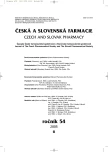Interconversion of Stereochemically Unstable Chiral Drugs: Utilization of Chromatographic Techniques for the Study of Enantiomerization, Calculation of Thermodynamic Parameters Part I: Theoretical Aspects
Authors:
A. Fedurcová; J. Lehotay; J. Čižmárik 1
Authors‘ workplace:
Slovenská technická univerzita v Bratislave, Fakulta chemickej a potravinárskej technológie, Katedra analytickej chémie, SR
; Univerzita Komenského v Bratislave, Farmaceutická fakulta, Katedra farmaceutickej chémie, SR
1
Published in:
Čes. slov. Farm., 2005; 54, 256-261
Category:
Review Articles
Overview
The paper explains the theoretical aspects of the process of enantiomerization and describes its characteristic features (generation of a plateau). In addition, some complications are presented that are produced by enantiomerization either from analytical or pharmacological points of view. It also defines the way of how to calculate energy barriers of enantiomerization according to the methods used for the separation of racemic mixtures (stopped-flow or dynamic chromatography). Mathematic models useful in deconvolution of chromatograms are also described. With the use of dynamic methods it is not possible to quantitatively evaluate the obtained chtromatograms and calculate thermodynamic parameters without computer-assisted deconvolution.
Key words:
enantiomerization – racemization – interconversion – configuration unstable drugs – kinetic rate constants
Labels
Pharmacy Clinical pharmacologyArticle was published in
Czech and Slovak Pharmacy

2005 Issue 6
Most read in this issue
- Contemporary Programme of Pharmaceutical Studies in Germany
- Logistics in the Pharmaceutical Service
- Composite Tincture from the Tops of the Purple Coneflower (Echinacea purpurea) and the Fruits of the Dog Rose (Rosa canina): Technology of Production and Evaluation of Quality
- Isotachophoretic Determination of Desloratadine in Tablets and Syrup
